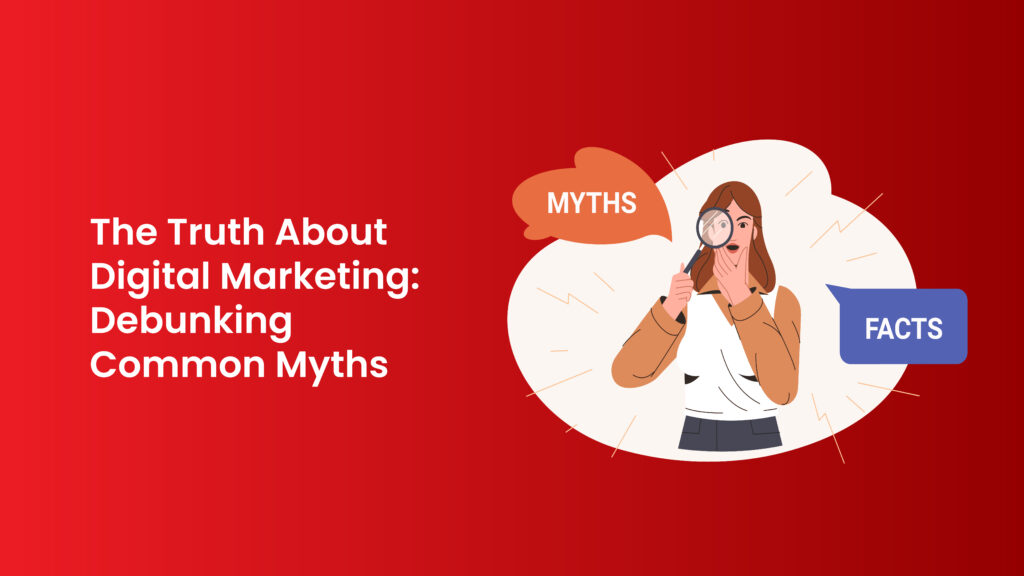Digital marketing has become an indispensable tool for businesses aiming to thrive in the modern era. Yet, amidst the myriad of strategies, platforms, and techniques, myths and misconceptions often cloud our understanding of what truly works. In this comprehensive guide, we’ll delve into the truth behind some of the pervasive myths surrounding digital marketing, equipping you with the knowledge needed to navigate this dynamic landscape effectively.
Myth 1: Digital Marketing Is Only for Big Businesses

There’s a prevailing misconception that digital marketing is exclusively reserved for large corporations with hefty budgets. However, the reality is far from it. In truth, digital marketing offers unparalleled opportunities for businesses of all sizes to compete on a level playing field.
With platforms like social media, content marketing, and email campaigns, even startups and small businesses can establish a formidable online presence and engage with their target audience effectively. Digital marketing isn’t just for the big players; it’s for anyone with a message and a desire to connect with their audience.
Myth 2: SEO Is Dead
Some skeptics argue that Search Engine Optimization (SEO) has lost its relevance in the age of social media dominance and paid advertising. While the SEO landscape has certainly evolved, organic search traffic remains a vital component of digital marketing strategy.
By focusing on quality content, user experience, and technical optimization, businesses can still achieve significant visibility in search engine results pages (SERPs). SEO isn’t dead; it’s more alive and essential than ever before. This assertion couldn’t be further from the truth.
Myth 3: Social Media Is Just for Millennials
Another prevalent myth is that social media platforms cater exclusively to younger demographics. While platforms like Instagram and Snapchat may have a predominantly youthful user base, the reality is that social media demographics are diverse and multifaceted.
By understanding your target demographic and choosing the right platforms, you can effectively engage with your audience regardless of age or demographic. From Facebook to LinkedIn, social media offers businesses an unparalleled opportunity to connect with audiences of all ages, interests, and backgrounds.
Myth 4: Email Marketing Is Dead
With the rise of social media and instant messaging apps, some have prematurely declared the death of email marketing. However, this assertion couldn’t be further from the truth. Email marketing remains one of the most effective channels for reaching and nurturing leads.
With personalized messaging, targeted campaigns, and automation tools, businesses can cultivate meaningful relationships with their audience and drive conversions. Email marketing continues to deliver impressive ROI, making it a valuable asset in any digital marketer’s toolkit.

Myth 5: More Traffic Equals More Sales
While driving traffic to your website is undoubtedly important, it’s not the sole determinant of success. Contrary to popular belief, simply increasing website traffic without a clear strategy for conversion is unlikely to yield meaningful results.
Instead, businesses should focus on attracting quality traffic that is more likely to convert into leads or customers. By optimizing your website for user experience, targeting the right audience, and providing valuable content, you can maximize the impact of your digital marketing efforts and drive sustainable growth.
Myth 6: The Quantity of Content Is More Important Than the Quality
Let’s dispel the notion that content isn’t crucial for your business right from the outset. In reality, the quality of your content holds equal, if not greater, significance compared to its quantity. Consider a scenario: Your website boasts 200 articles, hastily crafted without much finesse merely to populate your blog.
Now contrast that with a site featuring only 20 articles, each meticulously curated with expertise, authority, and engaging storytelling. These pieces are the product of extensive research, incorporating appropriate keywords and enriched with multimedia elements such as images, memes, and GIFs. However, it’s a common mistake to believe that sheer volume alone suffices.
Myth 6: Results Should Come Immediately
Directly addressing those individuals, it’s important to debunk a prevalent myth: effective marketing, particularly in the digital realm, demands both time and effort to yield results. Click here for further more information about SEO
Search Engine Optimization (SEO) necessitates patience before yielding noticeable outcomes, social media marketing requires a ramp-up period, and even advertising campaigns typically don’t deliver exceptional results right out of the gate.
Myth 7: AI Will Fix Everything
One of the more recent digital marketing misconceptions, though no less ludicrous than its predecessors, revolves around the role of artificial intelligence (AI). While AI can certainly streamline tasks and simplify workflows, it isn’t a panacea for all challenges, whether in digital marketing or beyond.
Unless you find yourself residing in the year 2160, AI doesn’t single-handedly propel your business to success, nor can you depend solely on it to drive profitability. Many marketers have fallen into the trap of over hyping recent AI advancements like Chat GPT or Jasper. While these tools can be useful for efficiency, they’re not a one-stop solution for all marketing needs.
Conclusion
In conclusion, understanding the truths and debunking the myths surrounding digital marketing is essential for success in today’s competitive landscape. By embracing proven strategies, challenging conventional wisdom, and staying informed about emerging trends, businesses can navigate the complexities of digital marketing with confidence.
Digital marketing isn’t a one-size-fits-all solution, but rather a dynamic and ever-evolving ecosystem that rewards creativity, adaptability, and strategic thinking. Armed with the knowledge gained from debunking these common myths, you’ll be better equipped to leverage the power of digital marketing and achieve your business objectives.

